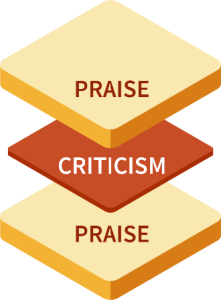Is it time to retire the feedback sandwich?

There seems to be a lot of talk about feedback these days. With work going remote, the traditional performance review being rethought, and companies struggling to recruit and retain talent, many organizations are taking a closer look at their feedback practices to make sure they stand up to today’s work environments. In that spirit, much of the advice about giving feedback is receiving closer scrutiny. This includes one of the most common approaches to feedback – the feedback sandwich.
What is the Feedback Sandwich?
The feedback sandwich is perhaps the most widely known and used feedback approach out there. It advises giving feedback in three steps: positive, negative, positive.

For example: “your presentation slides were well organized (positive), your numbers weren’t always as accurate as they should be (negative), but the overall impression was very professional (positive)”.
The general idea is that the feedback sandwich opens the listener to critical feedback by easing them into the discussion and showing your positive intentions. Some also hope that it will prevent the listener from feeling as though their entire value is being called into question.
Criticism of the Feedback Sandwich
“Recently the feedback sandwich has become the subject of criticism from publications like the Harvard Business Review, Forbes, and the Journal of Behavioral Studies in Business”
Critics argue that the juxtaposition of positive and negative feedback weakens both the positive and the negative (or corrective feedback). First, they say that it undermines corrective feedback. When you tuck corrective feedback between two pieces of positive, the logic goes, the overall impression can skew to the positive even if this is not the intention. The listener may consequently underestimate the seriousness of the corrective feedback and, in some cases, even ignore it. Second, the habitual use of the feedback sandwich makes people immune to positive feedback. Once they learn that positive feedback is always followed by the negative, they come to regard it as insincere and often don’t even hear it. In fact, in these cases, research suggests that the positive feedback increases the listener’s anxiety as she waits for the other shoe to drop.
Because of these concerns, many have suggested replacing the feedback sandwich with unadorned corrective feedback that has no association with positive feedback. And this is a reasonable suggestion, given the evidence. Many of us have personally experienced how confusing or manipulative it can seem to receive negative feedback right after positive, so it makes sense that the solution would be to keep positive and corrective feedback separate. But there’s also a good reason to suspect that this remedy is an overreaction based on an insufficiently nuanced view of the problem. Do the drawbacks of the feedback sandwich always outweigh the benefits? Is it always better to deliver positive and corrective feedback separately? Upon closer examination, the basic concerns really only apply to a single, fairly specific feedback situation: when your primary intention is to deliver exclusively corrective feedback.

What’s Wrong with the Criticism of the Feedback Sandwich?
Recent critiques of the feedback sandwich, knowingly or not, assume that feedback is essentially about a manager giving corrective feedback to a direct report on a single, very specific behavior. No doubt this is a common scenario that most of us will be familiar with. But it is only one of many types of situations where feedback is given. Sometimes we’re giving feedback to a peer, sometimes to a boss, sometimes to a direct report, and sometimes to a team. Sometimes we’re giving corrective feedback, other times positive feedback, other times praise, and a lot of times, we’re giving a combination of those. Sometimes we’re giving feedback related to a single behavior, sometimes to several behaviors, and other times on broad behavioral themes spanning weeks or months.
Imagine, for example, that you have a colleague who might benefit from some feedback on her body language during client presentations. There are some things you feel should be encouraged and others redirected. If you follow the advice of the feedback sandwich critics, does this mean you should have two separate meetings, one to discuss the positive feedback and another for the negative? If you will be giving all your feedback in one discussion, will it be a big problem if you mention the positive stuff first? The answer here is pretty obvious: of course not. For these reasons, as with all advice, we should treat the advice of the detractors with care. It’s not that their critiques are wrong – the problems they graciously point out are fundamentally correct and should be heeded by all. But we should be careful in applying their remedies across all of the varied feedback circumstances we encounter on a daily basis.
What should we do with the Feedback Sandwich?
In the end, the biggest problem with the feedback sandwich model isn’t that the model is flawed – it’s the very fact that it’s a model! There’s no question that, like most feedback models, it can be useful in a handful of circumstances. And, to the critics’ point, there’s no question that it can be detrimental in some circumstances. So, should we use it? Sometimes, yes! But if we truly want to equip ourselves to give feedback in any situation, we need to have a broader set of social tools at our disposal. We need to understand the psychological principles inherent in most feedback situations, learn how they present situationally, and learn how to manage those principles to navigate complex social interactions toward a productive conclusion. This is both an art and a science that can be learned with practice and the right coaching and instruction. It will never be as easy as memorizing a simple three- or four-step model – we are talking about humans dealing with humans after all. But if you want to give effective, meaningful feedback, you don’t have to throw out the feedback sandwich – just think bigger.


